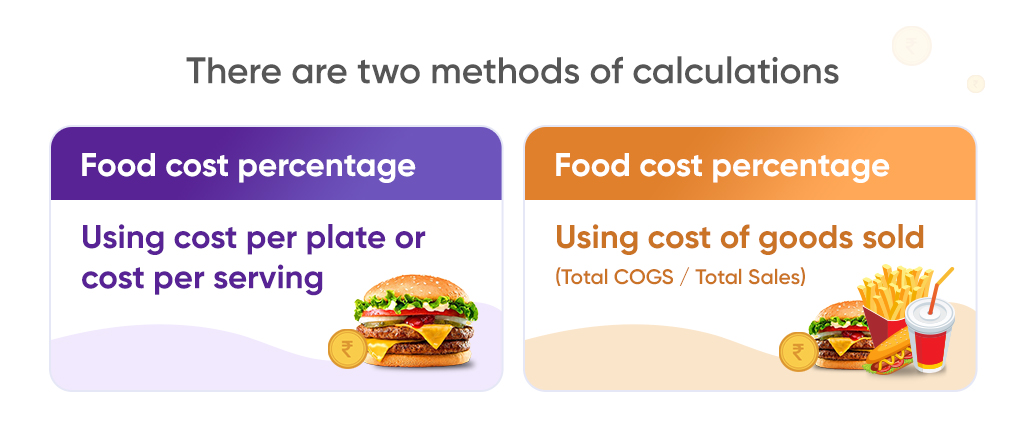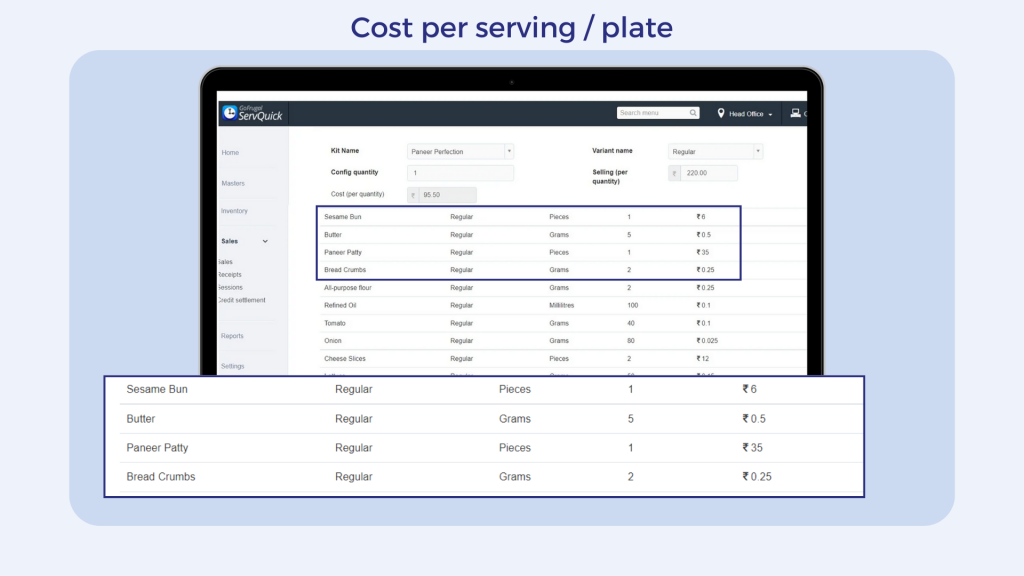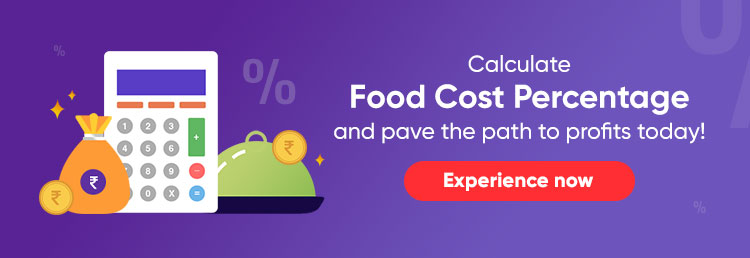
Running a restaurant is certainly not a piece of cake. Depending on the type, the average net operating margin of a restaurant varies between 3% to 9%. It is therefore essential for restaurants to focus on two major aspects: increasing revenues and reducing costs. Every restaurant allocates a major portion of their expenditure towards procuring ingredients, which are then transformed into delicious dishes. However, pricing them appropriately before printing them on the menu card is crucial – and this is where the food cost percentage formula comes into play.
The food cost percentage formula is the cardinal calculation towards cutting down costs. Carried out carefully, it can help you reduce expenses while boosting your sales and profits. On the flip side, improper calculations can result in a nightmare, with huge losses looming around.
Translation: if you do not calculate the food cost percentage formula correctly, your profitability might plummet to the depths of the Mariana Trench.
What is the food cost percentage formula?
Mathematically, food cost percentage is expressed as the percentage value of the total costs incurred for purchasing ingredients to the total sales generated by the restaurant.

Here’s a simple fictional illustration: Mr. Ram Sharma is the owner of Best Burgers – a fast food joint specializing in burgers and sandwiches. He wishes to calculate the food cost percentage value for one of his best-selling menu items: The Chicken Dominator. He comes up with the following numbers:
| Total cost to procure the ingredients | ₹ 2,500 |
| Total sales of The Chicken Dominator | ₹ 7,500 |
Therefore, the food cost percentage is:
Food cost percentage = (₹ 2,500/₹ 7,500) x 100 % = 33%
Thus, the food cost percentage for The Chicken Dominator is 33%. This means that for every ₹ 100 Mr. Ram earns from selling the burger, he has to spend ₹ 33 on procuring the ingredients for its preparation.
While there is no fixed ideal value for food cost percentage, for standardization across the different types of restaurants, the average value is estimated to lie in the range of 28% to 32%.
Why is food cost percentage formula important?
As explained earlier, food cost percentage is an essential metric for understanding your costs and aiming to reduce them, while simultaneously increasing your restaurant’s profits. Food cost percentage also helps you with the following:
- Engineering the Right Menu: Based on pre-determined margins, this formula helps you in the pricing strategy for your dishes and creating the menu using the most profitable ones.
- Identifying the Right Supplier: Buying certain ingredients in bulk, that have minimal impact on the finished dish yet absorb greater costs, can be simplified by calculating the food cost percentage. This enables you to identify the right supplier and preserve the quality of your ingredients.
- Quantifying the Right Costs: Food cost percentage helps you identify your expenditure towards procuring ingredients and come up with methods to minimize the same.
- Managing the Right Recipes: It also helps you experiment with recipes by altering ingredients and portion sizes based on the ingredient costs.
- Reordering the Right Quantity: Wastage of ingredients has always been one of the most detrimental causes of cost escalation and inventory loss. By understanding the food costs, you will be empowered to understand the right quantity required and order at the right time.
How to calculate the food cost percentage?
Calculating the food cost percentage is quite simple. There are two methods of calculation, and both are equally important – while one gives you a detailed, granular view of the costs, the second gives you a bird’s eye view of the total costs versus sales. Let us understand how to calculate the food cost percentage using both these methods.

Calculation using Cost per Plate or Cost per Serving
In this method, we calculate the food cost percentage based on the cost incurred per plate or per serving of a dish and its selling price. Let us bring back Best Burgers to illustrate this method:
Mr. Ram now wishes to introduce a new burger to his vegetarian customers – The Paneer Perfection. He writes down the recipe that had been passed down to him by his grandma:
- 1 sesame bun
- 5 g butter (for toasting the bun)
- 1 paneer patty (grounded)
- 2 g of bread crumbs (for coating the patty)
- 2 g of all-purpose flour (for coating the patty)
- 100 ml refined oil (for frying the patty)
- 2 slices of tomato
- 2 slices of onion
- 2 slices of cheese
- 1 leaf of lettuce
- 5 g of Mexican sauce
- 2 sachets of tomato ketchup
Ram then identifies the cost of ingredients per serving:
| S.No. | Item | Qty. required per serving | Cost per serving |
|---|---|---|---|
| 1 | Sesame Bun | 1 piece | ₹ 6.00 |
| 2 | Butter | 5 g | ₹ 2.50 |
| 3 | Paneer Patty | 1 piece | ₹ 35.00 |
| 4 | Bread crumbs | 2 g | ₹ 0.50 |
| 5 | All-purpose flour | 2 g | ₹ 0.50 |
| 6 | Refined oil | 100 ml | ₹ 10.00 |
| 7 | Tomato | 40 g | ₹ 4.00 |
| 8 | Onion | 80 g | ₹ 2.00 |
| 9 | Lettuce | 50 g | ₹ 7.50 |
| 10 | Cheese Slices | 2 slices | ₹ 12.00 |
| 11 | Mexican Sauce | 5 g | ₹ 0.50 |
| 12 | Tomato Ketchup | 2 sachets | ₹ 3.00 |
| Total Cost | ₹ 95.50 |

Ram also factors in the additional overhead costs (i.e., staffing, electricity, rent, etc.) and estimates it to be ₹ 20 for 1 Paneer Perfection.
Therefore, the total cost for 1 serving of Paneer Perfection (i.e., 1 burger) comes to : ₹ 115.50. Assuming Ram sells it at a price of ₹220, the food cost percentage comes to:
| Food Cost Percentage |
|---|
| =Cost per serving / Selling price per serving |
| = ₹ 115.50 / ₹ 220 |
| = 0.525 or 52.5% |
Calculation using Cost of Goods Sold (COGS)
To use this method, Ram has to first calculate the Cost of Goods Sold or COGS. COGS is calculated for a particular period – a week, a month, a quarter, or even a year. In simple terms, COGS refers to the revenue that Ram has generated through the sale of the food items prepared from the ingredients that have been procured and used.
This formula has two major components:
- The ingredients that have been procured in the particular period, i.e., the total cost of goods sold: This can be calculated by monitoring your inventory. There are three important metrics you need to cover here:
- Opening Stock: The inventory amount at the beginning of the particular period
- Purchases: The inventory amount purchased during the particular period
- Closing Stock: The inventory amount at the end of the particular period
- The revenue generated by these ingredients, i.e., the total sales amount in the particular period.
Let us assume Ram is calculating the COGS for the month of June 2022. He has taken a deep-dive into his restaurant reports and come up with the following numbers:
- Opening stock amount in June 2022: ₹ 7,500
- Purchases made in June 2022: ₹ 4,700
- Closing stock amount in June 2022: ₹5,200
The total cost of goods sold is calculated as:
Opening stock amount + Purchase amount – Closing stock amount
Therefore, COGS in June 2022: ₹ 7,500 + ₹ 4,700 – ₹ 5,200 = ₹ 7,000
Ram now looks at his restaurant reports once again and observes that he has generated a revenue of ₹ 22,400 in June 2022.
Therefore, the food cost percentage, using the COGS is calculated as:
| Food Cost Percentage |
|---|
| = Total COGS / Total Sales |
| = (Opening stock amount + Purchase amount – Closing stock amount)/Total Sales |
| = ₹ 7,000 / ₹ 22,400 |
| = 0.32 or 32% |
Calculating the Benchmark: The Ideal Food Cost Percentage
The ideal food cost percentage, also known as theoretical food cost percentage, expresses the ratio of costs to sales in an ideal environment. An ideal environment can be defined as one where there is no wastage, pilferage or theft of ingredients, and that all the ingredients are consumed accurately for the preparation of food items, i.e., each amount of ingredient contributes to revenue.
As mentioned earlier, the average value of the ideal food cost percentage lies around 28% to 32%. Reverting to the example, if Ram fixes the ideal food cost percentage for Best Burgers at 31% based on his research – the variance between the theoretical and actual food cost percentage is 1%. This means that Ram is using his ingredients properly, and that the restaurant is reaping an almost maximum profit for every meal served.
Benefits of Calculating Food Cost Percentage
You would agree by now that calculating food cost percentage is as necessary as taking a shot of Covaxin or Covishield. Aside from the obvious benefit of cost reduction, here are some other benefits that you can enjoy by employing this simple formula:
- Pricing based on margins: Pricing your menu items based on the theoretical food cost percentage will help you generate profits as well as understand the customer response to the price changes.
- Establishing the breakeven: Determine the breakeven sales revenue and quantity based on your food costs accurately, by calculating the food cost percentage.
- Disbanding non-selling items: Identify the items that have generated the least sales revenue and cut back on procurement and production costs.
- Altering your menu: Explore new recipes intelligently by adjusting portion sizes and ingredient quantities to add a splash of creativity to your menu.
The most obvious benefit is that your profitability is bound to increase. But what’s the catch? How much of a profitability increase are we talking about? Let us go back to the example of Best Burgers:
Assuming Ram has a food cost percentage of 31%, and his total sales in June 2022 are ₹ 10,000. This translates to a total cost of ₹ 3,100 (31% of ₹ 10,000). Therefore, his gross profits are ₹ 6,900, i.e., 69%. Assuming staff costs and fixed costs are ₹ 2,500 and ₹1,500 respectively, Ram has a net profit of ₹ 2,900.
Let us say Ram monitors his inventory, procures low-cost supplies and manages to reduce portion sizes for a few of his dishes, to bring down the food cost percentage to 27% in July 2022. Again, assume his total revenue for July is ₹ 10,000. The net profit that he would have earned in July 2022 would be ₹ 3,300.
| Metric | June 2022 | July 2022 |
|---|---|---|
| Revenue | ₹ 10,000 | ₹ 10,000 |
| Food Costs | ₹ 3,100 | ₹ 2,700 |
| Staff Costs | ₹ 2,500 | ₹ 2,500 |
| Fixed Costs | ₹ 1,500 | ₹ 1,500 |
| Net Profit | ₹ 2,900 | ₹ 3,300 |
Keeping sales as a constant, a 4% decrease in costs translates to a 13.8% increase in profits! That’s the sheer strength of the food cost percentage formula!
Understanding and applying the food cost percentage formula can benefit your business and boost your profitability to a greater extent. To accurately calculate this metric, relying on a smart restaurant management system is the prescribed path. Gofrugal offers you the best Inventory Management, Accounting Management & Recipe Management modules which require minimal skills and the least training.
Start your journey with Gofrugal today, and watch your bottom-line bloom into the fruits of phenomenal profits!
